Usability Evaluation of Curry PC World: Human Factors & System Design
VerifiedAdded on 2023/06/08
|25
|5774
|477
Report
AI Summary
This report presents a comprehensive usability evaluation of the Curry PC World interactive system, focusing on human factors in system design. It begins with an introduction to interactive systems and their users, followed by a detailed methodology for usability evaluation, including usability testing, expert reviews, and heuristic evaluations. The report defines the evaluation methods used, such as usability tests, system usability scales, and heuristic evaluations, and presents evidence collected regarding the system's usability. The findings identify key usability issues and provide recommendations for improvement, aligning with usability metrics such as effectiveness, efficiency, and satisfaction. The evaluation also considers international standards like ISO 9241 and ISO 13407 to ensure compliance and best practices in human-centered design. The analysis encompasses various aspects of the website, including navigation, user interface, and overall user experience, ultimately aiming to enhance the system's usability and user satisfaction.
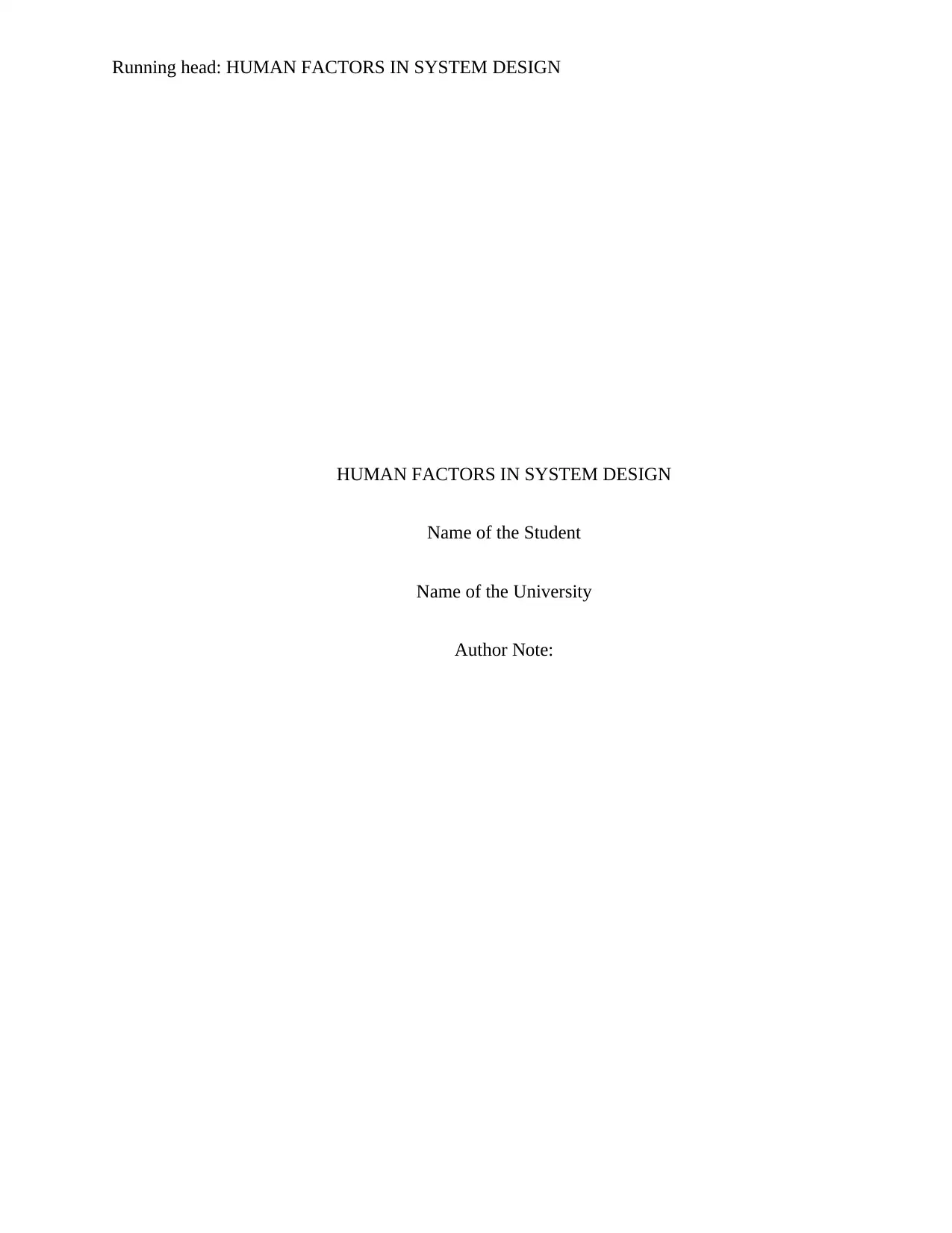
Running head: HUMAN FACTORS IN SYSTEM DESIGN
HUMAN FACTORS IN SYSTEM DESIGN
Name of the Student
Name of the University
Author Note:
HUMAN FACTORS IN SYSTEM DESIGN
Name of the Student
Name of the University
Author Note:
Paraphrase This Document
Need a fresh take? Get an instant paraphrase of this document with our AI Paraphraser
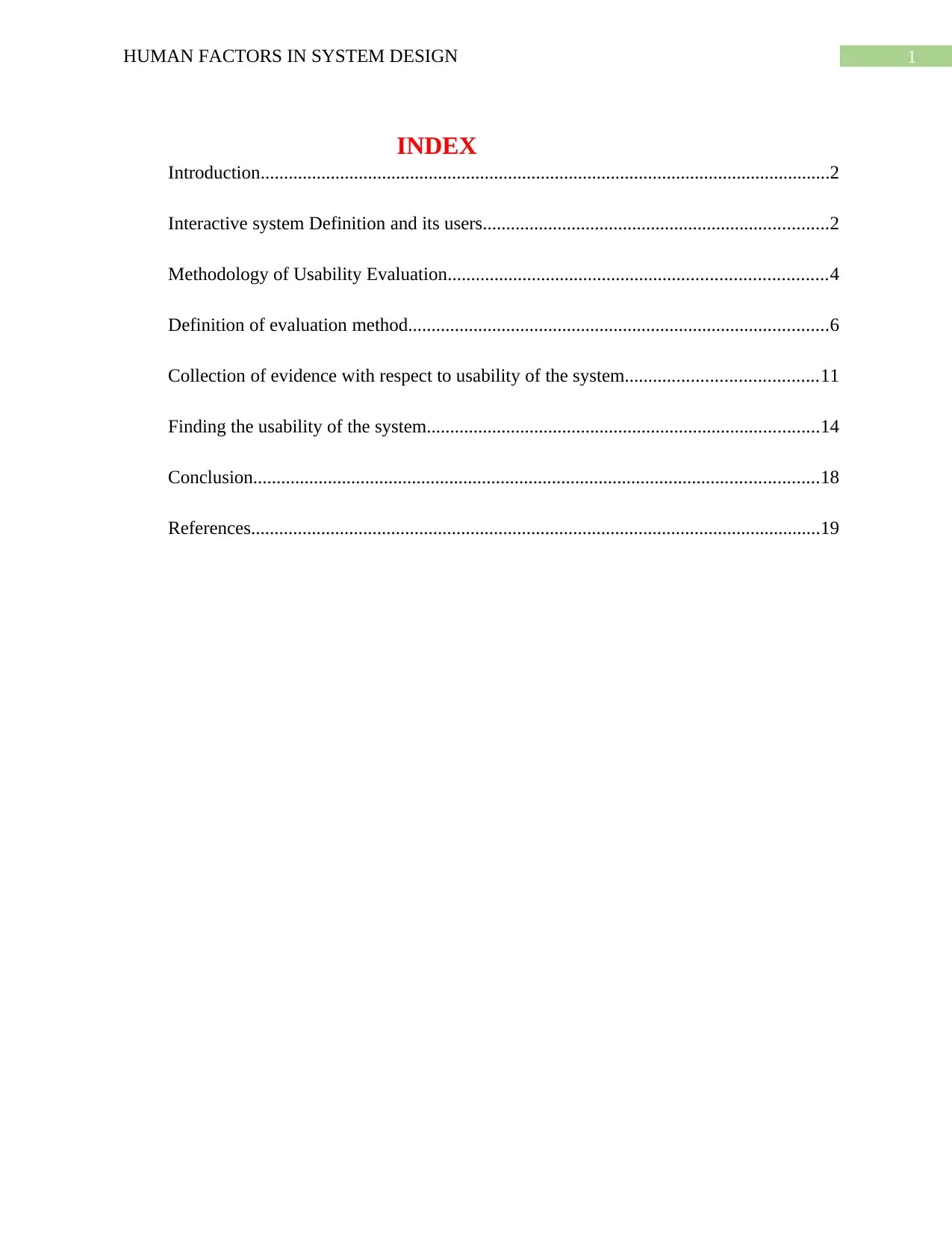
1HUMAN FACTORS IN SYSTEM DESIGN
INDEX
Introduction..........................................................................................................................2
Interactive system Definition and its users..........................................................................2
Methodology of Usability Evaluation.................................................................................4
Definition of evaluation method..........................................................................................6
Collection of evidence with respect to usability of the system.........................................11
Finding the usability of the system....................................................................................14
Conclusion.........................................................................................................................18
References..........................................................................................................................19
INDEX
Introduction..........................................................................................................................2
Interactive system Definition and its users..........................................................................2
Methodology of Usability Evaluation.................................................................................4
Definition of evaluation method..........................................................................................6
Collection of evidence with respect to usability of the system.........................................11
Finding the usability of the system....................................................................................14
Conclusion.........................................................................................................................18
References..........................................................................................................................19
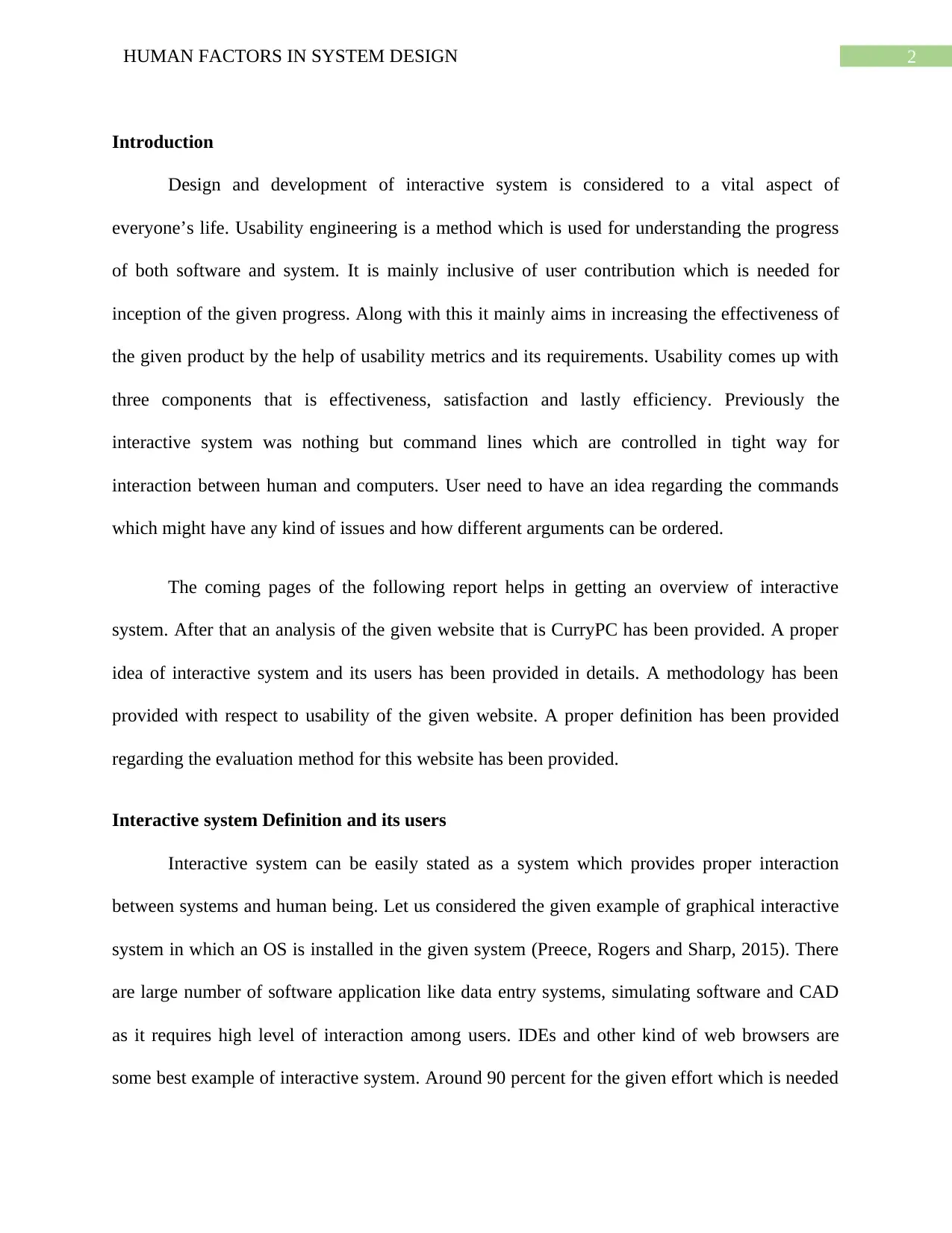
2HUMAN FACTORS IN SYSTEM DESIGN
Introduction
Design and development of interactive system is considered to a vital aspect of
everyone’s life. Usability engineering is a method which is used for understanding the progress
of both software and system. It is mainly inclusive of user contribution which is needed for
inception of the given progress. Along with this it mainly aims in increasing the effectiveness of
the given product by the help of usability metrics and its requirements. Usability comes up with
three components that is effectiveness, satisfaction and lastly efficiency. Previously the
interactive system was nothing but command lines which are controlled in tight way for
interaction between human and computers. User need to have an idea regarding the commands
which might have any kind of issues and how different arguments can be ordered.
The coming pages of the following report helps in getting an overview of interactive
system. After that an analysis of the given website that is CurryPC has been provided. A proper
idea of interactive system and its users has been provided in details. A methodology has been
provided with respect to usability of the given website. A proper definition has been provided
regarding the evaluation method for this website has been provided.
Interactive system Definition and its users
Interactive system can be easily stated as a system which provides proper interaction
between systems and human being. Let us considered the given example of graphical interactive
system in which an OS is installed in the given system (Preece, Rogers and Sharp, 2015). There
are large number of software application like data entry systems, simulating software and CAD
as it requires high level of interaction among users. IDEs and other kind of web browsers are
some best example of interactive system. Around 90 percent for the given effort which is needed
Introduction
Design and development of interactive system is considered to a vital aspect of
everyone’s life. Usability engineering is a method which is used for understanding the progress
of both software and system. It is mainly inclusive of user contribution which is needed for
inception of the given progress. Along with this it mainly aims in increasing the effectiveness of
the given product by the help of usability metrics and its requirements. Usability comes up with
three components that is effectiveness, satisfaction and lastly efficiency. Previously the
interactive system was nothing but command lines which are controlled in tight way for
interaction between human and computers. User need to have an idea regarding the commands
which might have any kind of issues and how different arguments can be ordered.
The coming pages of the following report helps in getting an overview of interactive
system. After that an analysis of the given website that is CurryPC has been provided. A proper
idea of interactive system and its users has been provided in details. A methodology has been
provided with respect to usability of the given website. A proper definition has been provided
regarding the evaluation method for this website has been provided.
Interactive system Definition and its users
Interactive system can be easily stated as a system which provides proper interaction
between systems and human being. Let us considered the given example of graphical interactive
system in which an OS is installed in the given system (Preece, Rogers and Sharp, 2015). There
are large number of software application like data entry systems, simulating software and CAD
as it requires high level of interaction among users. IDEs and other kind of web browsers are
some best example of interactive system. Around 90 percent for the given effort which is needed
⊘ This is a preview!⊘
Do you want full access?
Subscribe today to unlock all pages.

Trusted by 1+ million students worldwide
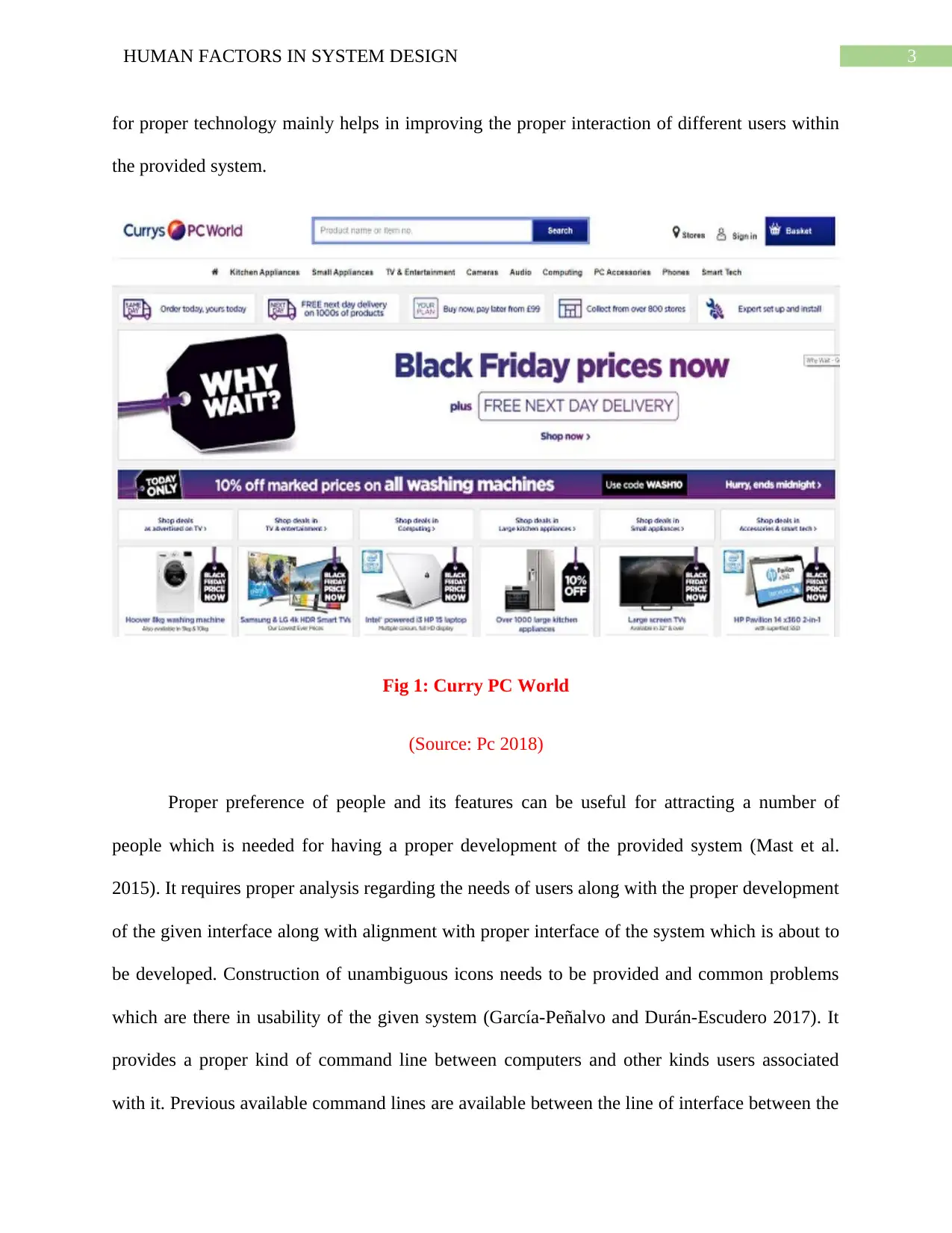
3HUMAN FACTORS IN SYSTEM DESIGN
for proper technology mainly helps in improving the proper interaction of different users within
the provided system.
Fig 1: Curry PC World
(Source: Pc 2018)
Proper preference of people and its features can be useful for attracting a number of
people which is needed for having a proper development of the provided system (Mast et al.
2015). It requires proper analysis regarding the needs of users along with the proper development
of the given interface along with alignment with proper interface of the system which is about to
be developed. Construction of unambiguous icons needs to be provided and common problems
which are there in usability of the given system (García-Peñalvo and Durán-Escudero 2017). It
provides a proper kind of command line between computers and other kinds users associated
with it. Previous available command lines are available between the line of interface between the
for proper technology mainly helps in improving the proper interaction of different users within
the provided system.
Fig 1: Curry PC World
(Source: Pc 2018)
Proper preference of people and its features can be useful for attracting a number of
people which is needed for having a proper development of the provided system (Mast et al.
2015). It requires proper analysis regarding the needs of users along with the proper development
of the given interface along with alignment with proper interface of the system which is about to
be developed. Construction of unambiguous icons needs to be provided and common problems
which are there in usability of the given system (García-Peñalvo and Durán-Escudero 2017). It
provides a proper kind of command line between computers and other kinds users associated
with it. Previous available command lines are available between the line of interface between the
Paraphrase This Document
Need a fresh take? Get an instant paraphrase of this document with our AI Paraphraser
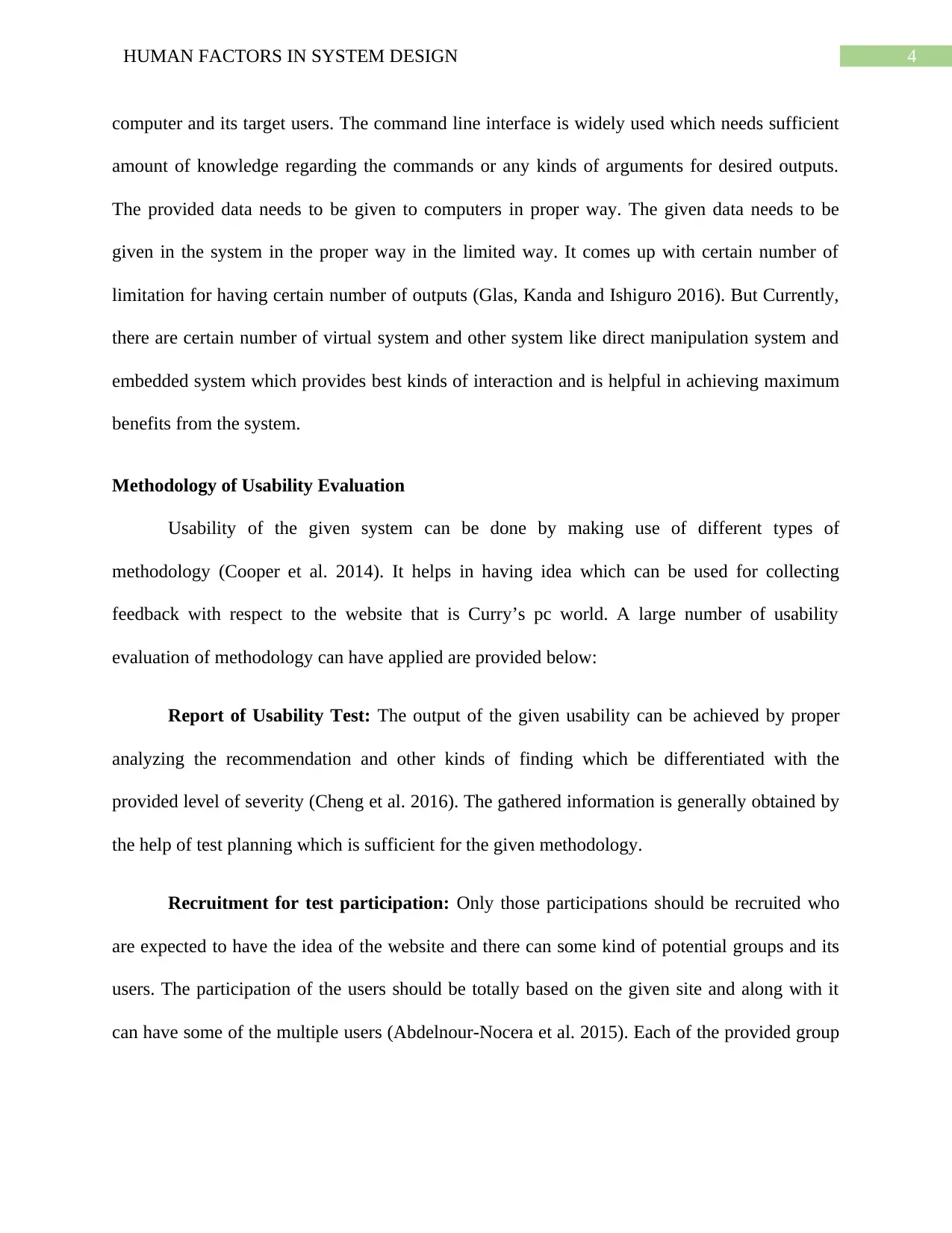
4HUMAN FACTORS IN SYSTEM DESIGN
computer and its target users. The command line interface is widely used which needs sufficient
amount of knowledge regarding the commands or any kinds of arguments for desired outputs.
The provided data needs to be given to computers in proper way. The given data needs to be
given in the system in the proper way in the limited way. It comes up with certain number of
limitation for having certain number of outputs (Glas, Kanda and Ishiguro 2016). But Currently,
there are certain number of virtual system and other system like direct manipulation system and
embedded system which provides best kinds of interaction and is helpful in achieving maximum
benefits from the system.
Methodology of Usability Evaluation
Usability of the given system can be done by making use of different types of
methodology (Cooper et al. 2014). It helps in having idea which can be used for collecting
feedback with respect to the website that is Curry’s pc world. A large number of usability
evaluation of methodology can have applied are provided below:
Report of Usability Test: The output of the given usability can be achieved by proper
analyzing the recommendation and other kinds of finding which be differentiated with the
provided level of severity (Cheng et al. 2016). The gathered information is generally obtained by
the help of test planning which is sufficient for the given methodology.
Recruitment for test participation: Only those participations should be recruited who
are expected to have the idea of the website and there can some kind of potential groups and its
users. The participation of the users should be totally based on the given site and along with it
can have some of the multiple users (Abdelnour-Nocera et al. 2015). Each of the provided group
computer and its target users. The command line interface is widely used which needs sufficient
amount of knowledge regarding the commands or any kinds of arguments for desired outputs.
The provided data needs to be given to computers in proper way. The given data needs to be
given in the system in the proper way in the limited way. It comes up with certain number of
limitation for having certain number of outputs (Glas, Kanda and Ishiguro 2016). But Currently,
there are certain number of virtual system and other system like direct manipulation system and
embedded system which provides best kinds of interaction and is helpful in achieving maximum
benefits from the system.
Methodology of Usability Evaluation
Usability of the given system can be done by making use of different types of
methodology (Cooper et al. 2014). It helps in having idea which can be used for collecting
feedback with respect to the website that is Curry’s pc world. A large number of usability
evaluation of methodology can have applied are provided below:
Report of Usability Test: The output of the given usability can be achieved by proper
analyzing the recommendation and other kinds of finding which be differentiated with the
provided level of severity (Cheng et al. 2016). The gathered information is generally obtained by
the help of test planning which is sufficient for the given methodology.
Recruitment for test participation: Only those participations should be recruited who
are expected to have the idea of the website and there can some kind of potential groups and its
users. The participation of the users should be totally based on the given site and along with it
can have some of the multiple users (Abdelnour-Nocera et al. 2015). Each of the provided group
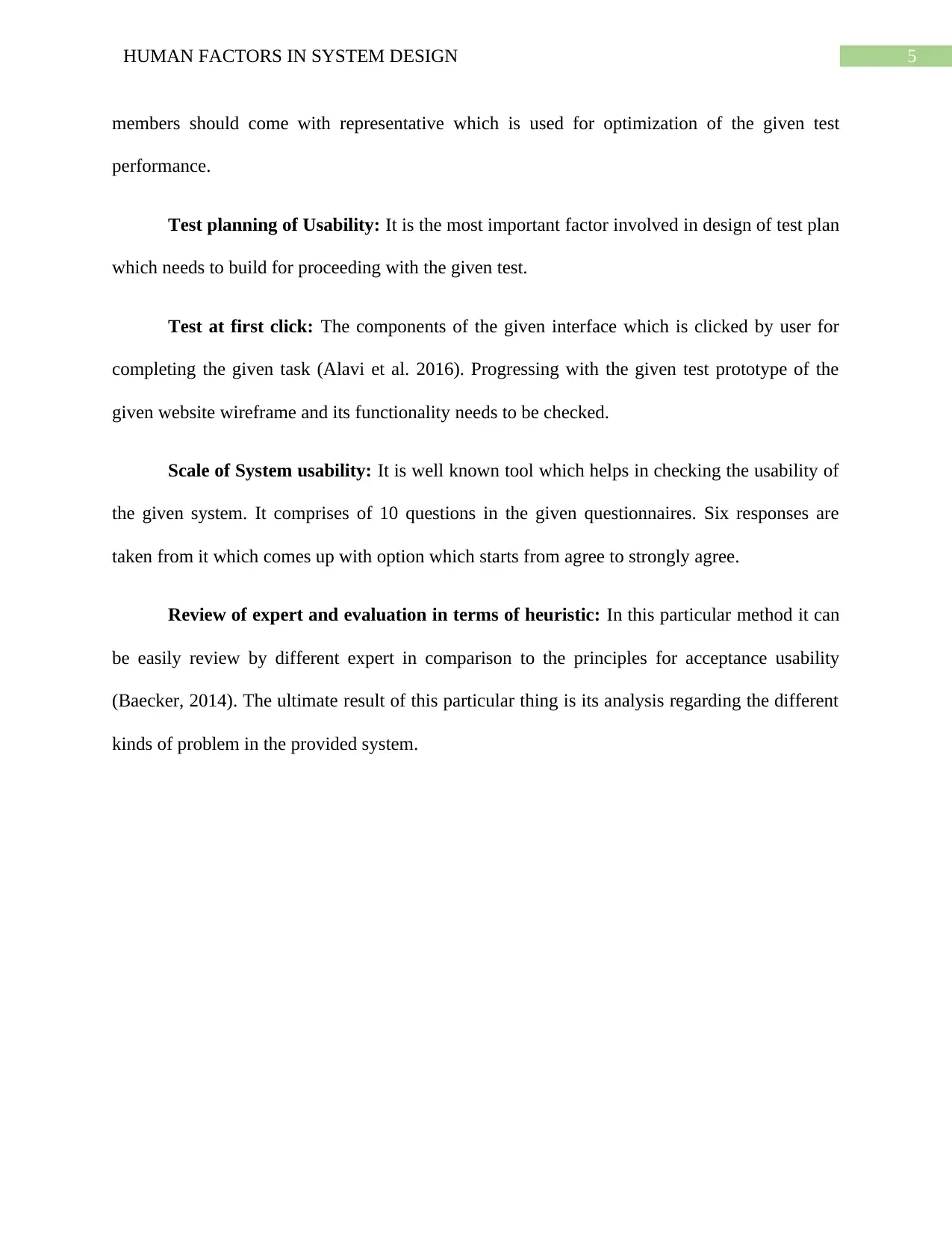
5HUMAN FACTORS IN SYSTEM DESIGN
members should come with representative which is used for optimization of the given test
performance.
Test planning of Usability: It is the most important factor involved in design of test plan
which needs to build for proceeding with the given test.
Test at first click: The components of the given interface which is clicked by user for
completing the given task (Alavi et al. 2016). Progressing with the given test prototype of the
given website wireframe and its functionality needs to be checked.
Scale of System usability: It is well known tool which helps in checking the usability of
the given system. It comprises of 10 questions in the given questionnaires. Six responses are
taken from it which comes up with option which starts from agree to strongly agree.
Review of expert and evaluation in terms of heuristic: In this particular method it can
be easily review by different expert in comparison to the principles for acceptance usability
(Baecker, 2014). The ultimate result of this particular thing is its analysis regarding the different
kinds of problem in the provided system.
members should come with representative which is used for optimization of the given test
performance.
Test planning of Usability: It is the most important factor involved in design of test plan
which needs to build for proceeding with the given test.
Test at first click: The components of the given interface which is clicked by user for
completing the given task (Alavi et al. 2016). Progressing with the given test prototype of the
given website wireframe and its functionality needs to be checked.
Scale of System usability: It is well known tool which helps in checking the usability of
the given system. It comprises of 10 questions in the given questionnaires. Six responses are
taken from it which comes up with option which starts from agree to strongly agree.
Review of expert and evaluation in terms of heuristic: In this particular method it can
be easily review by different expert in comparison to the principles for acceptance usability
(Baecker, 2014). The ultimate result of this particular thing is its analysis regarding the different
kinds of problem in the provided system.
⊘ This is a preview!⊘
Do you want full access?
Subscribe today to unlock all pages.

Trusted by 1+ million students worldwide
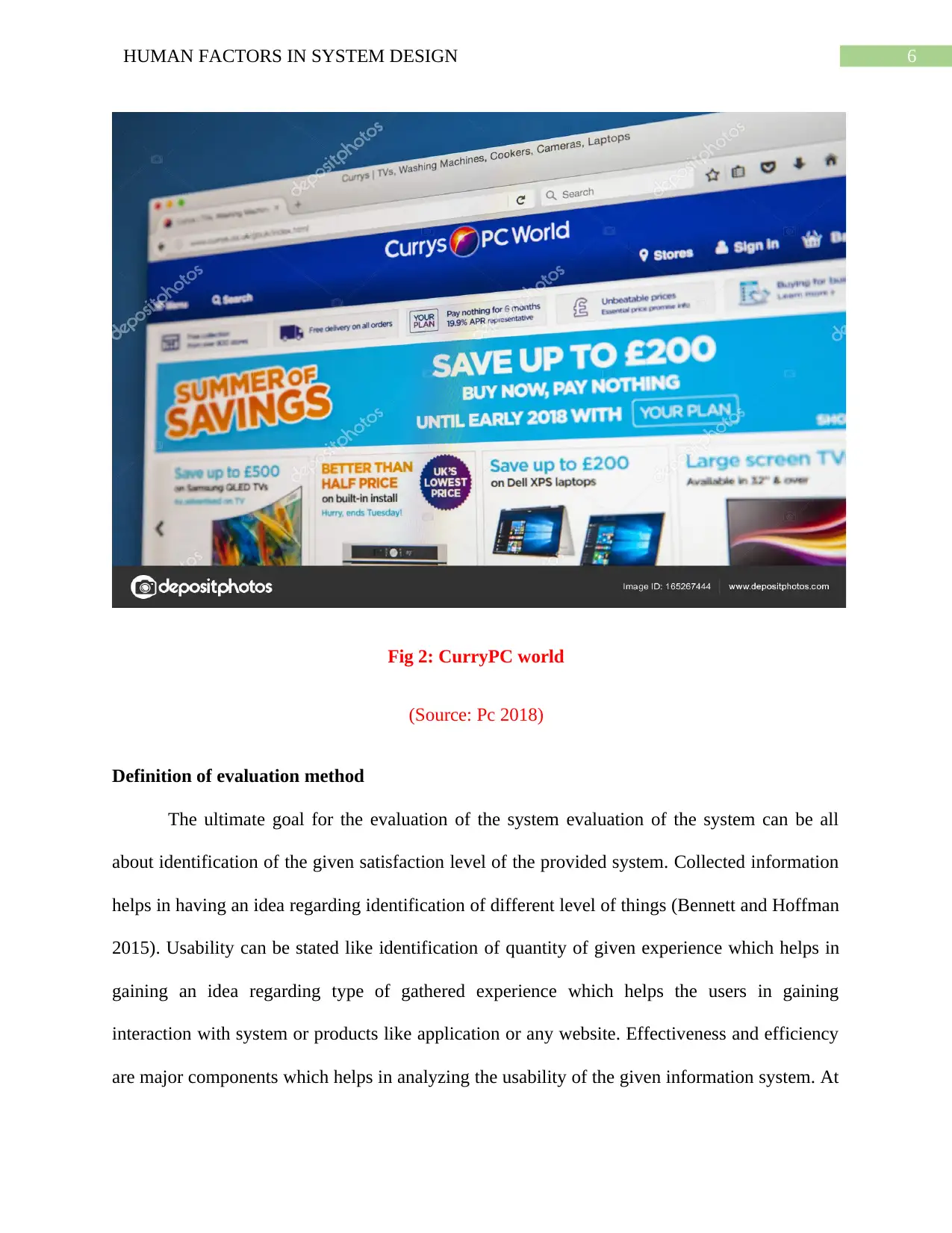
6HUMAN FACTORS IN SYSTEM DESIGN
Fig 2: CurryPC world
(Source: Pc 2018)
Definition of evaluation method
The ultimate goal for the evaluation of the system evaluation of the system can be all
about identification of the given satisfaction level of the provided system. Collected information
helps in having an idea regarding identification of different level of things (Bennett and Hoffman
2015). Usability can be stated like identification of quantity of given experience which helps in
gaining an idea regarding type of gathered experience which helps the users in gaining
interaction with system or products like application or any website. Effectiveness and efficiency
are major components which helps in analyzing the usability of the given information system. At
Fig 2: CurryPC world
(Source: Pc 2018)
Definition of evaluation method
The ultimate goal for the evaluation of the system evaluation of the system can be all
about identification of the given satisfaction level of the provided system. Collected information
helps in having an idea regarding identification of different level of things (Bennett and Hoffman
2015). Usability can be stated like identification of quantity of given experience which helps in
gaining an idea regarding type of gathered experience which helps the users in gaining
interaction with system or products like application or any website. Effectiveness and efficiency
are major components which helps in analyzing the usability of the given information system. At
Paraphrase This Document
Need a fresh take? Get an instant paraphrase of this document with our AI Paraphraser
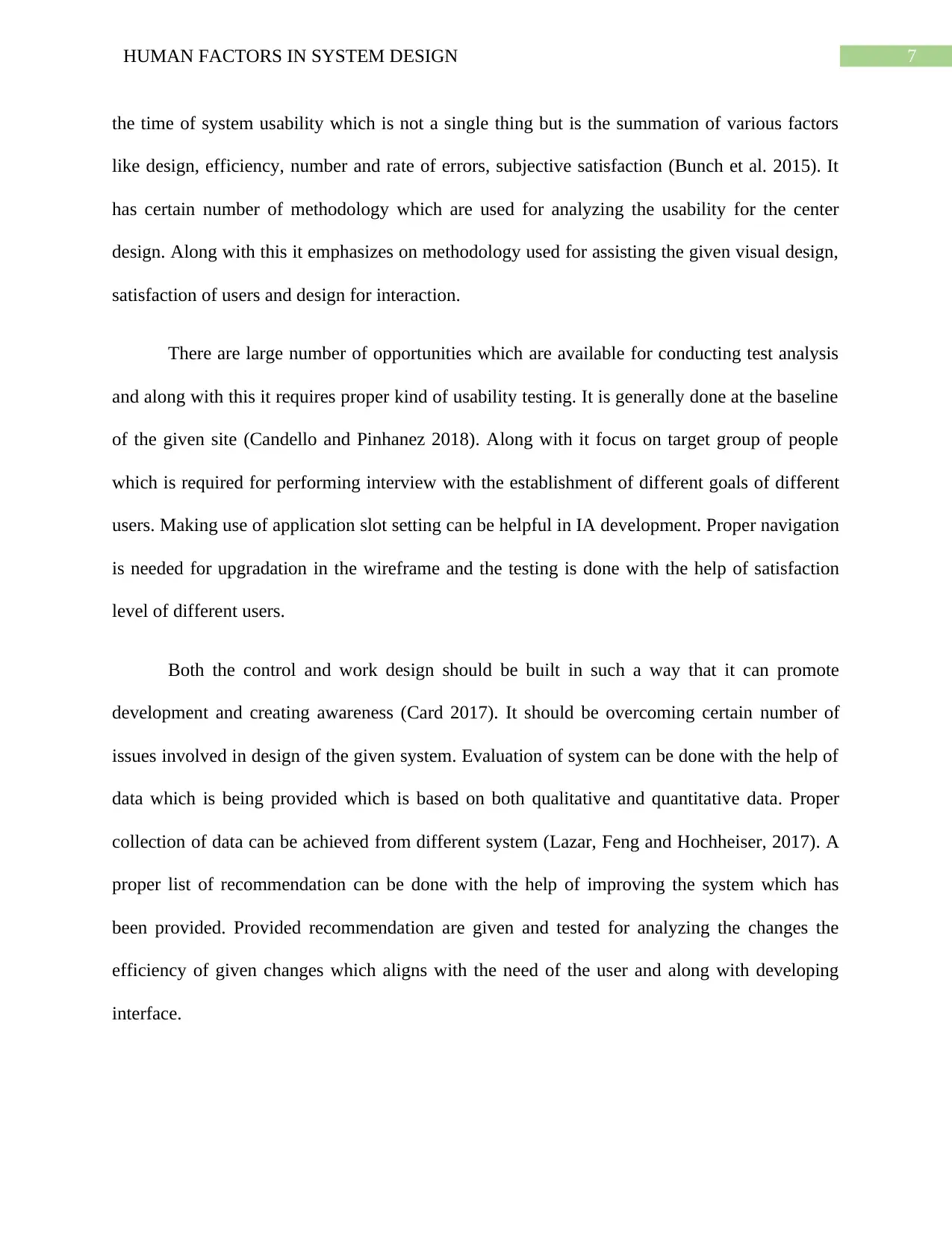
7HUMAN FACTORS IN SYSTEM DESIGN
the time of system usability which is not a single thing but is the summation of various factors
like design, efficiency, number and rate of errors, subjective satisfaction (Bunch et al. 2015). It
has certain number of methodology which are used for analyzing the usability for the center
design. Along with this it emphasizes on methodology used for assisting the given visual design,
satisfaction of users and design for interaction.
There are large number of opportunities which are available for conducting test analysis
and along with this it requires proper kind of usability testing. It is generally done at the baseline
of the given site (Candello and Pinhanez 2018). Along with it focus on target group of people
which is required for performing interview with the establishment of different goals of different
users. Making use of application slot setting can be helpful in IA development. Proper navigation
is needed for upgradation in the wireframe and the testing is done with the help of satisfaction
level of different users.
Both the control and work design should be built in such a way that it can promote
development and creating awareness (Card 2017). It should be overcoming certain number of
issues involved in design of the given system. Evaluation of system can be done with the help of
data which is being provided which is based on both qualitative and quantitative data. Proper
collection of data can be achieved from different system (Lazar, Feng and Hochheiser, 2017). A
proper list of recommendation can be done with the help of improving the system which has
been provided. Provided recommendation are given and tested for analyzing the changes the
efficiency of given changes which aligns with the need of the user and along with developing
interface.
the time of system usability which is not a single thing but is the summation of various factors
like design, efficiency, number and rate of errors, subjective satisfaction (Bunch et al. 2015). It
has certain number of methodology which are used for analyzing the usability for the center
design. Along with this it emphasizes on methodology used for assisting the given visual design,
satisfaction of users and design for interaction.
There are large number of opportunities which are available for conducting test analysis
and along with this it requires proper kind of usability testing. It is generally done at the baseline
of the given site (Candello and Pinhanez 2018). Along with it focus on target group of people
which is required for performing interview with the establishment of different goals of different
users. Making use of application slot setting can be helpful in IA development. Proper navigation
is needed for upgradation in the wireframe and the testing is done with the help of satisfaction
level of different users.
Both the control and work design should be built in such a way that it can promote
development and creating awareness (Card 2017). It should be overcoming certain number of
issues involved in design of the given system. Evaluation of system can be done with the help of
data which is being provided which is based on both qualitative and quantitative data. Proper
collection of data can be achieved from different system (Lazar, Feng and Hochheiser, 2017). A
proper list of recommendation can be done with the help of improving the system which has
been provided. Provided recommendation are given and tested for analyzing the changes the
efficiency of given changes which aligns with the need of the user and along with developing
interface.
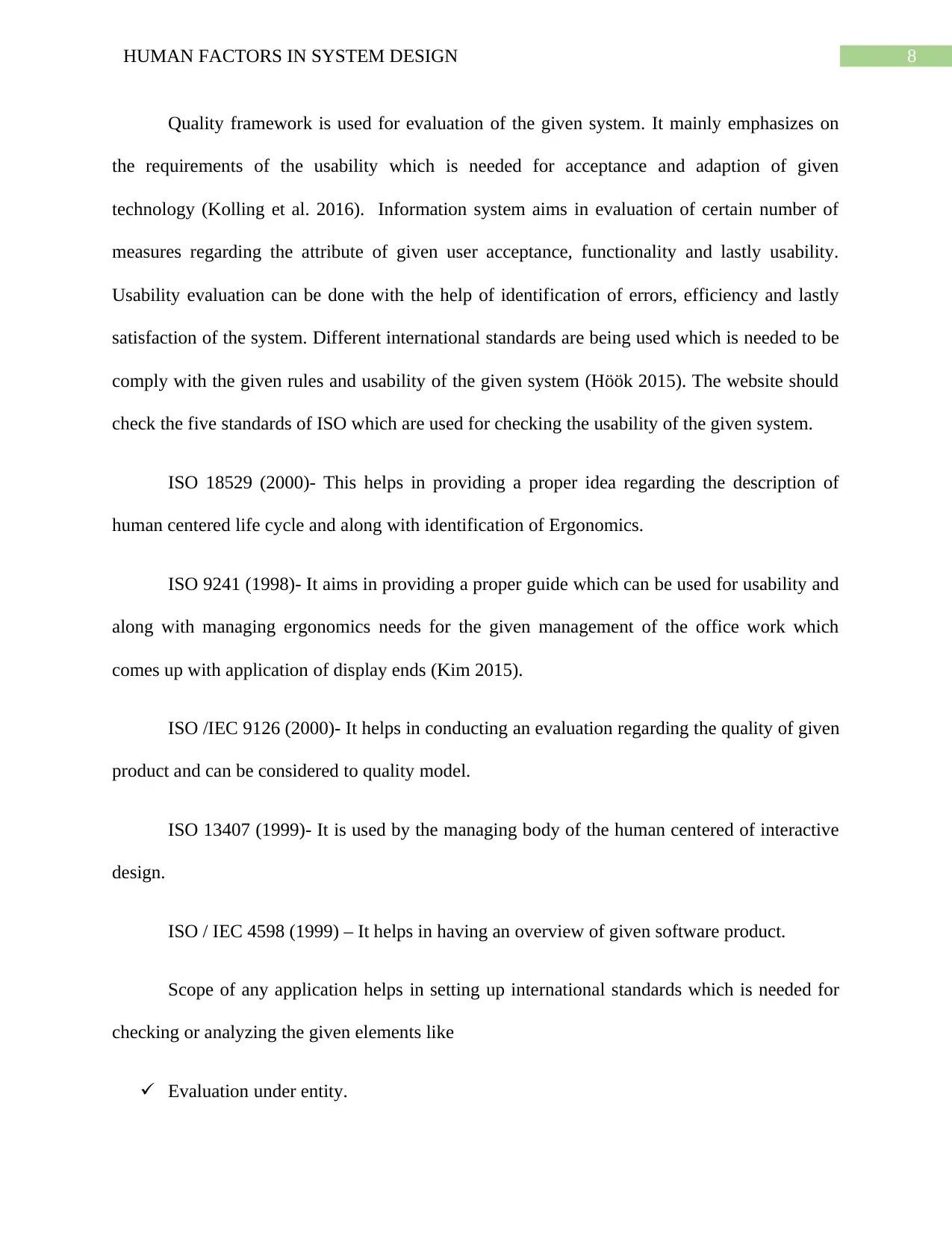
8HUMAN FACTORS IN SYSTEM DESIGN
Quality framework is used for evaluation of the given system. It mainly emphasizes on
the requirements of the usability which is needed for acceptance and adaption of given
technology (Kolling et al. 2016). Information system aims in evaluation of certain number of
measures regarding the attribute of given user acceptance, functionality and lastly usability.
Usability evaluation can be done with the help of identification of errors, efficiency and lastly
satisfaction of the system. Different international standards are being used which is needed to be
comply with the given rules and usability of the given system (Höök 2015). The website should
check the five standards of ISO which are used for checking the usability of the given system.
ISO 18529 (2000)- This helps in providing a proper idea regarding the description of
human centered life cycle and along with identification of Ergonomics.
ISO 9241 (1998)- It aims in providing a proper guide which can be used for usability and
along with managing ergonomics needs for the given management of the office work which
comes up with application of display ends (Kim 2015).
ISO /IEC 9126 (2000)- It helps in conducting an evaluation regarding the quality of given
product and can be considered to quality model.
ISO 13407 (1999)- It is used by the managing body of the human centered of interactive
design.
ISO / IEC 4598 (1999) – It helps in having an overview of given software product.
Scope of any application helps in setting up international standards which is needed for
checking or analyzing the given elements like
Evaluation under entity.
Quality framework is used for evaluation of the given system. It mainly emphasizes on
the requirements of the usability which is needed for acceptance and adaption of given
technology (Kolling et al. 2016). Information system aims in evaluation of certain number of
measures regarding the attribute of given user acceptance, functionality and lastly usability.
Usability evaluation can be done with the help of identification of errors, efficiency and lastly
satisfaction of the system. Different international standards are being used which is needed to be
comply with the given rules and usability of the given system (Höök 2015). The website should
check the five standards of ISO which are used for checking the usability of the given system.
ISO 18529 (2000)- This helps in providing a proper idea regarding the description of
human centered life cycle and along with identification of Ergonomics.
ISO 9241 (1998)- It aims in providing a proper guide which can be used for usability and
along with managing ergonomics needs for the given management of the office work which
comes up with application of display ends (Kim 2015).
ISO /IEC 9126 (2000)- It helps in conducting an evaluation regarding the quality of given
product and can be considered to quality model.
ISO 13407 (1999)- It is used by the managing body of the human centered of interactive
design.
ISO / IEC 4598 (1999) – It helps in having an overview of given software product.
Scope of any application helps in setting up international standards which is needed for
checking or analyzing the given elements like
Evaluation under entity.
⊘ This is a preview!⊘
Do you want full access?
Subscribe today to unlock all pages.

Trusted by 1+ million students worldwide
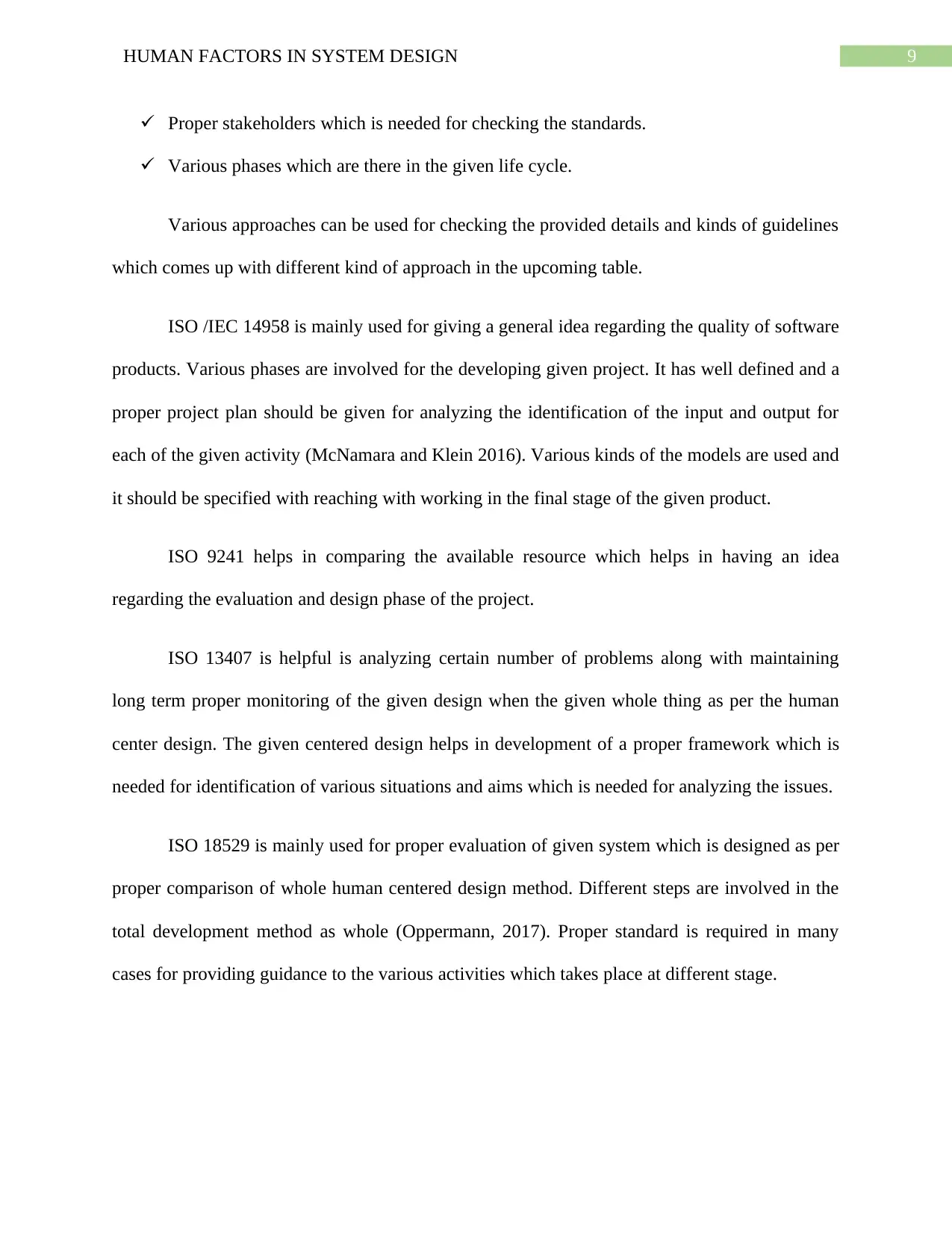
9HUMAN FACTORS IN SYSTEM DESIGN
Proper stakeholders which is needed for checking the standards.
Various phases which are there in the given life cycle.
Various approaches can be used for checking the provided details and kinds of guidelines
which comes up with different kind of approach in the upcoming table.
ISO /IEC 14958 is mainly used for giving a general idea regarding the quality of software
products. Various phases are involved for the developing given project. It has well defined and a
proper project plan should be given for analyzing the identification of the input and output for
each of the given activity (McNamara and Klein 2016). Various kinds of the models are used and
it should be specified with reaching with working in the final stage of the given product.
ISO 9241 helps in comparing the available resource which helps in having an idea
regarding the evaluation and design phase of the project.
ISO 13407 is helpful is analyzing certain number of problems along with maintaining
long term proper monitoring of the given design when the given whole thing as per the human
center design. The given centered design helps in development of a proper framework which is
needed for identification of various situations and aims which is needed for analyzing the issues.
ISO 18529 is mainly used for proper evaluation of given system which is designed as per
proper comparison of whole human centered design method. Different steps are involved in the
total development method as whole (Oppermann, 2017). Proper standard is required in many
cases for providing guidance to the various activities which takes place at different stage.
Proper stakeholders which is needed for checking the standards.
Various phases which are there in the given life cycle.
Various approaches can be used for checking the provided details and kinds of guidelines
which comes up with different kind of approach in the upcoming table.
ISO /IEC 14958 is mainly used for giving a general idea regarding the quality of software
products. Various phases are involved for the developing given project. It has well defined and a
proper project plan should be given for analyzing the identification of the input and output for
each of the given activity (McNamara and Klein 2016). Various kinds of the models are used and
it should be specified with reaching with working in the final stage of the given product.
ISO 9241 helps in comparing the available resource which helps in having an idea
regarding the evaluation and design phase of the project.
ISO 13407 is helpful is analyzing certain number of problems along with maintaining
long term proper monitoring of the given design when the given whole thing as per the human
center design. The given centered design helps in development of a proper framework which is
needed for identification of various situations and aims which is needed for analyzing the issues.
ISO 18529 is mainly used for proper evaluation of given system which is designed as per
proper comparison of whole human centered design method. Different steps are involved in the
total development method as whole (Oppermann, 2017). Proper standard is required in many
cases for providing guidance to the various activities which takes place at different stage.
Paraphrase This Document
Need a fresh take? Get an instant paraphrase of this document with our AI Paraphraser
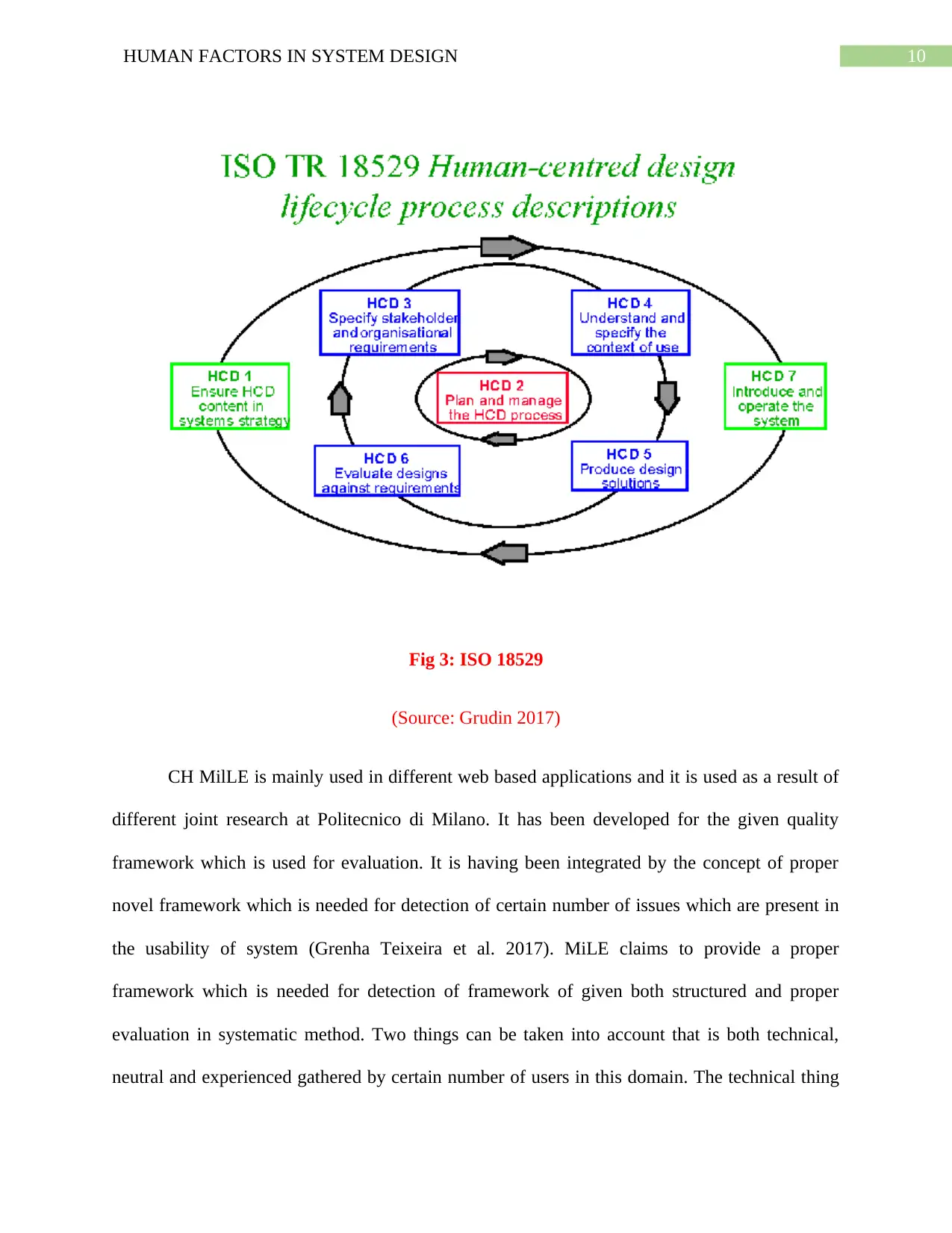
10HUMAN FACTORS IN SYSTEM DESIGN
Fig 3: ISO 18529
(Source: Grudin 2017)
CH MilLE is mainly used in different web based applications and it is used as a result of
different joint research at Politecnico di Milano. It has been developed for the given quality
framework which is used for evaluation. It is having been integrated by the concept of proper
novel framework which is needed for detection of certain number of issues which are present in
the usability of system (Grenha Teixeira et al. 2017). MiLE claims to provide a proper
framework which is needed for detection of framework of given both structured and proper
evaluation in systematic method. Two things can be taken into account that is both technical,
neutral and experienced gathered by certain number of users in this domain. The technical thing
Fig 3: ISO 18529
(Source: Grudin 2017)
CH MilLE is mainly used in different web based applications and it is used as a result of
different joint research at Politecnico di Milano. It has been developed for the given quality
framework which is used for evaluation. It is having been integrated by the concept of proper
novel framework which is needed for detection of certain number of issues which are present in
the usability of system (Grenha Teixeira et al. 2017). MiLE claims to provide a proper
framework which is needed for detection of framework of given both structured and proper
evaluation in systematic method. Two things can be taken into account that is both technical,
neutral and experienced gathered by certain number of users in this domain. The technical thing
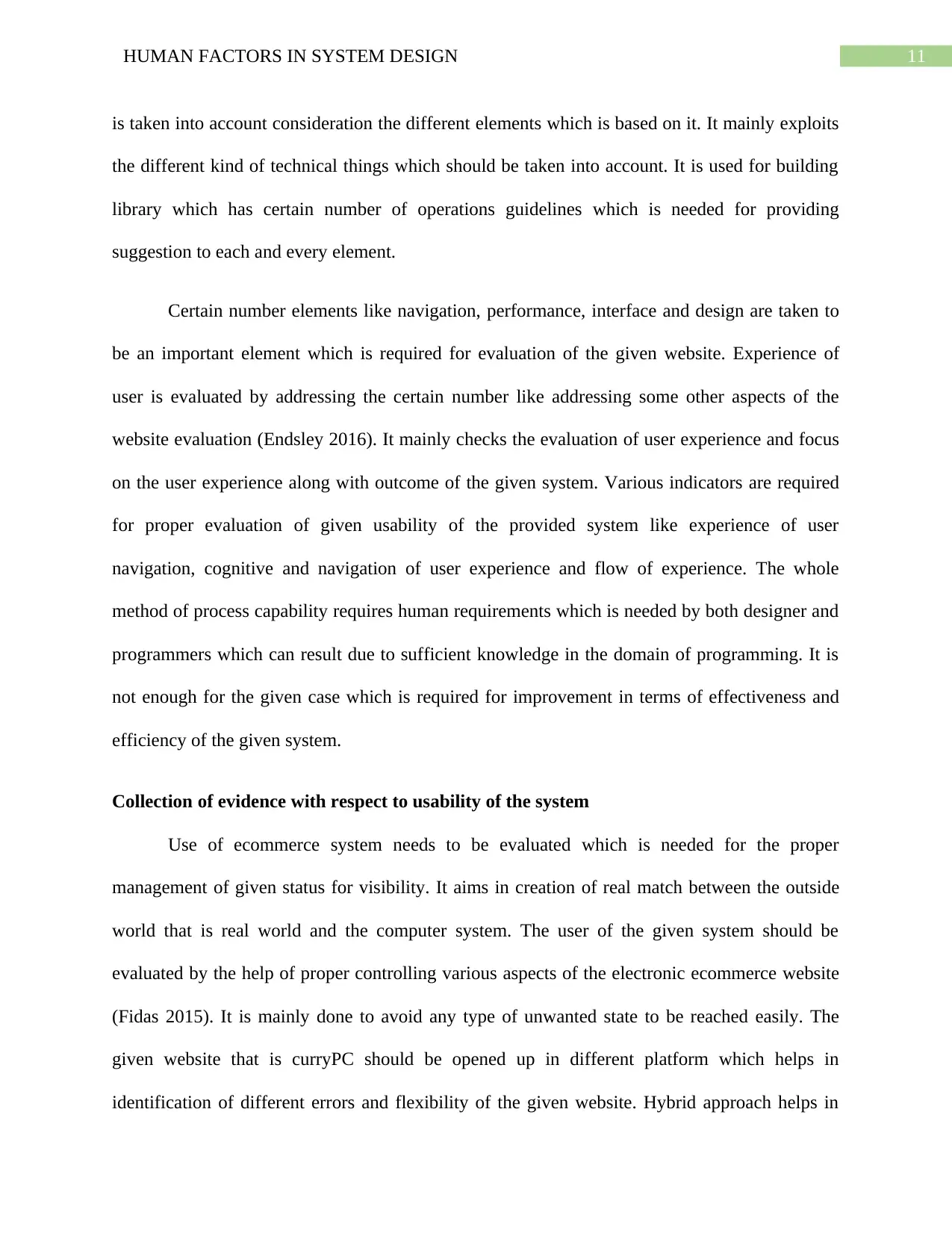
11HUMAN FACTORS IN SYSTEM DESIGN
is taken into account consideration the different elements which is based on it. It mainly exploits
the different kind of technical things which should be taken into account. It is used for building
library which has certain number of operations guidelines which is needed for providing
suggestion to each and every element.
Certain number elements like navigation, performance, interface and design are taken to
be an important element which is required for evaluation of the given website. Experience of
user is evaluated by addressing the certain number like addressing some other aspects of the
website evaluation (Endsley 2016). It mainly checks the evaluation of user experience and focus
on the user experience along with outcome of the given system. Various indicators are required
for proper evaluation of given usability of the provided system like experience of user
navigation, cognitive and navigation of user experience and flow of experience. The whole
method of process capability requires human requirements which is needed by both designer and
programmers which can result due to sufficient knowledge in the domain of programming. It is
not enough for the given case which is required for improvement in terms of effectiveness and
efficiency of the given system.
Collection of evidence with respect to usability of the system
Use of ecommerce system needs to be evaluated which is needed for the proper
management of given status for visibility. It aims in creation of real match between the outside
world that is real world and the computer system. The user of the given system should be
evaluated by the help of proper controlling various aspects of the electronic ecommerce website
(Fidas 2015). It is mainly done to avoid any type of unwanted state to be reached easily. The
given website that is curryPC should be opened up in different platform which helps in
identification of different errors and flexibility of the given website. Hybrid approach helps in
is taken into account consideration the different elements which is based on it. It mainly exploits
the different kind of technical things which should be taken into account. It is used for building
library which has certain number of operations guidelines which is needed for providing
suggestion to each and every element.
Certain number elements like navigation, performance, interface and design are taken to
be an important element which is required for evaluation of the given website. Experience of
user is evaluated by addressing the certain number like addressing some other aspects of the
website evaluation (Endsley 2016). It mainly checks the evaluation of user experience and focus
on the user experience along with outcome of the given system. Various indicators are required
for proper evaluation of given usability of the provided system like experience of user
navigation, cognitive and navigation of user experience and flow of experience. The whole
method of process capability requires human requirements which is needed by both designer and
programmers which can result due to sufficient knowledge in the domain of programming. It is
not enough for the given case which is required for improvement in terms of effectiveness and
efficiency of the given system.
Collection of evidence with respect to usability of the system
Use of ecommerce system needs to be evaluated which is needed for the proper
management of given status for visibility. It aims in creation of real match between the outside
world that is real world and the computer system. The user of the given system should be
evaluated by the help of proper controlling various aspects of the electronic ecommerce website
(Fidas 2015). It is mainly done to avoid any type of unwanted state to be reached easily. The
given website that is curryPC should be opened up in different platform which helps in
identification of different errors and flexibility of the given website. Hybrid approach helps in
⊘ This is a preview!⊘
Do you want full access?
Subscribe today to unlock all pages.

Trusted by 1+ million students worldwide
1 out of 25
Related Documents
Your All-in-One AI-Powered Toolkit for Academic Success.
+13062052269
info@desklib.com
Available 24*7 on WhatsApp / Email
![[object Object]](/_next/static/media/star-bottom.7253800d.svg)
Unlock your academic potential
Copyright © 2020–2025 A2Z Services. All Rights Reserved. Developed and managed by ZUCOL.





